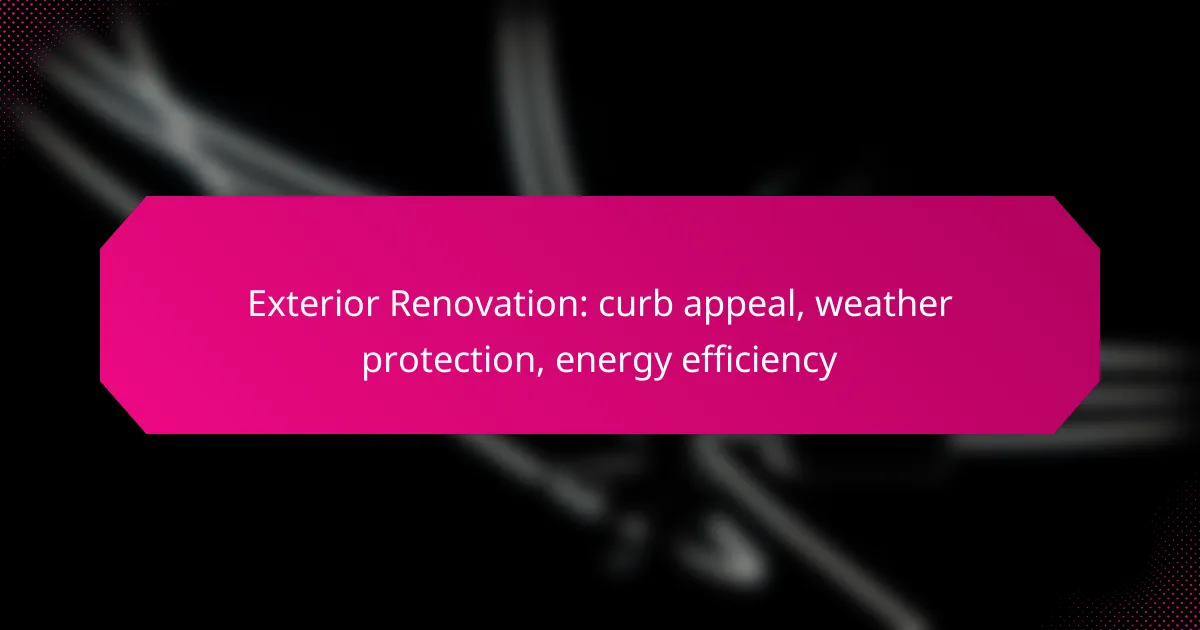Exterior renovation plays a crucial role in enhancing a property’s curb appeal, providing both aesthetic improvements and practical benefits. By selecting the right materials for weather protection and upgrading energy efficiency features, homeowners can create a more inviting and sustainable living space while potentially increasing their property’s market value.

How can exterior renovation enhance curb appeal in the UK?
Exterior renovation can significantly boost curb appeal in the UK by improving the visual attractiveness and overall condition of a property. This not only makes a home more inviting but can also increase its market value and energy efficiency.
Fresh paint and siding options
Applying fresh paint or updating siding materials can dramatically change the appearance of a home. Consider using durable, weather-resistant paints that can withstand the UK’s varied climate, such as acrylic or elastomeric options.
When selecting siding, options like brick, wood, or composite materials can enhance both aesthetics and protection. Choose colors that complement the surrounding environment and adhere to local planning regulations if applicable.
Landscaping improvements
Landscaping plays a crucial role in enhancing curb appeal. Simple improvements, such as planting seasonal flowers, maintaining a tidy lawn, and adding decorative elements like garden borders, can create a welcoming atmosphere.
Consider incorporating native plants that require less maintenance and are more resilient to local weather conditions. Regular upkeep, such as pruning and mulching, will keep the landscape looking fresh and inviting.
Door and window upgrades
Upgrading doors and windows can significantly enhance both curb appeal and energy efficiency. Opt for modern designs that align with the architectural style of your home, while ensuring they meet energy performance standards.
Replacing old windows with double or triple glazing can improve insulation and reduce heating costs. Additionally, a new front door can make a strong first impression, so choose one that is both stylish and secure.
Outdoor lighting enhancements
Installing outdoor lighting can highlight architectural features and improve safety. Use LED fixtures for energy efficiency and longevity, and consider motion-sensor lights for added security.
Pathway lights and spotlights can create a warm ambiance and guide visitors to your entrance. Ensure the lighting complements the overall design of your home and landscape.
Driveway and walkway renovations
Renovating driveways and walkways can enhance functionality and aesthetics. Consider materials like block paving, gravel, or concrete, which can withstand the UK’s weather while providing a clean look.
Ensure that pathways are well-maintained and free of cracks or weeds. Adding borders or decorative stones can further elevate the visual appeal and create a cohesive look with the rest of the property.

What are the best materials for weather protection?
The best materials for weather protection include options that effectively shield your home from moisture, wind, and temperature fluctuations. Selecting durable materials can enhance your home’s longevity while improving energy efficiency and curb appeal.
Vinyl siding benefits
Vinyl siding is a popular choice for weather protection due to its resistance to moisture and rot. It requires minimal maintenance and is available in various colors and styles, allowing homeowners to enhance curb appeal without frequent repainting.
This material is also energy-efficient, as it can be installed with insulation to improve thermal performance. When choosing vinyl siding, look for options with a high R-value to maximize energy savings.
Metal roofing advantages
Metal roofing is highly effective for weather protection, offering durability and resistance to extreme weather conditions. It can withstand heavy rain, snow, and high winds, making it a reliable choice for various climates.
Additionally, metal roofs reflect sunlight, which can help reduce cooling costs in warmer months. When considering metal roofing, ensure it meets local building codes and is installed by a qualified professional for optimal performance.
Weather-resistant windows
Weather-resistant windows are designed to prevent air and water infiltration, enhancing your home’s energy efficiency. Look for windows with double or triple glazing and low-emissivity (Low-E) coatings to minimize heat loss.
Proper installation is crucial; ensure that windows are sealed correctly to avoid drafts and leaks. Regular maintenance, such as checking seals and cleaning frames, will help maintain their weather-resistant properties over time.
Insulated doors
Insulated doors provide excellent weather protection by minimizing heat transfer and reducing energy costs. They are available in various materials, including fiberglass and steel, which offer durability and security.
When selecting insulated doors, consider options with a high R-value and ensure they fit snugly within the frame to prevent drafts. Regularly inspect door seals and weather stripping to maintain their effectiveness against the elements.

How does exterior renovation improve energy efficiency?
Exterior renovation enhances energy efficiency by upgrading insulation, windows, and integrating smart technologies, which collectively reduce energy consumption and lower utility bills. These improvements not only create a more comfortable living environment but also contribute to environmental sustainability.
Insulation types and benefits
Choosing the right insulation type is crucial for maximizing energy efficiency. Common options include fiberglass, foam board, and spray foam, each offering varying R-values, which measure thermal resistance. For instance, spray foam provides superior insulation and air sealing, making it ideal for attics and walls.
When selecting insulation, consider factors like climate, installation costs, and potential energy savings. In colder regions, higher R-values are recommended to combat heat loss, while milder climates may require less insulation. Proper installation is key to achieving the desired energy efficiency.
Energy-efficient windows
Energy-efficient windows significantly reduce heat transfer, helping maintain indoor temperatures and lowering heating and cooling costs. Look for windows with double or triple glazing, low-emissivity (Low-E) coatings, and gas fills like argon or krypton for optimal performance.
When replacing windows, consider the U-factor and solar heat gain coefficient (SHGC) ratings. A lower U-factor indicates better insulation, while an appropriate SHGC can help manage solar heat gain, especially in sunny areas. Investing in quality windows can yield substantial long-term savings on energy bills.
Solar panel installations
Installing solar panels can dramatically enhance energy efficiency by generating renewable energy for your home. These systems can offset electricity costs and may even allow homeowners to sell excess energy back to the grid, depending on local regulations and incentives.
Before installation, assess your roof’s orientation, shading, and structural integrity. Most residential solar systems require a significant upfront investment, but federal and state incentives can reduce costs. Consider consulting with a local solar provider to evaluate potential savings and financing options.
Smart home technology integration
Integrating smart home technology can optimize energy use and improve efficiency. Smart thermostats, lighting systems, and energy monitors allow homeowners to track and control energy consumption in real-time, leading to informed decisions about usage patterns.
When implementing smart technology, prioritize devices that offer compatibility with existing systems and user-friendly interfaces. Look for features like scheduling, remote access, and energy usage reports to maximize savings. Regularly updating software and maintaining devices ensures they operate efficiently and effectively.

What are the costs associated with exterior renovation in the UK?
The costs of exterior renovation in the UK can vary significantly based on the scope of the project, materials chosen, and labor expenses. Homeowners should budget for a range of expenses, including siding, roofing, and landscaping, to enhance curb appeal, protect against weather, and improve energy efficiency.
Average pricing for siding
The average cost for siding installation in the UK typically ranges from £50 to £100 per square meter, depending on the material selected. Vinyl siding tends to be on the lower end of the scale, while wood or stone options can be more expensive.
When considering siding, it’s essential to factor in installation costs, which can add another £20 to £40 per square meter. Ensure you choose a reputable contractor to avoid common pitfalls like poor installation or subpar materials.
Cost of roofing materials
Roofing material costs in the UK can vary widely, with options ranging from £40 to £100 per square meter. Asphalt shingles are generally the most affordable, while slate and tile roofs can be significantly more expensive.
In addition to material costs, labor for roofing installation can add £50 to £70 per square meter. It’s advisable to get multiple quotes and check for warranties on both materials and workmanship to ensure long-term value.
Landscaping budget considerations
Landscaping budgets in the UK can vary based on the complexity of the design and the materials used, typically ranging from £1,000 to £5,000 for a complete overhaul. Simple projects like planting shrubs or laying turf can be done for less, while intricate designs with hardscaping can increase costs.
When planning your landscaping, consider ongoing maintenance costs, which can add up over time. Hiring a professional landscaper can ensure a well-executed design, but be sure to compare quotes and check references to avoid overspending.

What factors should be considered when planning an exterior renovation?
When planning an exterior renovation, it is crucial to consider factors such as local building regulations, the desired curb appeal, weather protection, and energy efficiency. These elements will not only affect the aesthetic and functionality of your home but also ensure compliance with legal requirements and optimize your investment.
Local building regulations
Understanding local building regulations is essential for any exterior renovation project. These regulations can dictate everything from the types of materials you can use to the height and design of structures. Failing to adhere to these rules can result in fines or the need to redo work that does not meet standards.
Before starting your renovation, check with your local zoning office or building department. They can provide information on permits required, setback requirements, and any restrictions on architectural styles. For example, historic districts may have stricter guidelines that preserve the area’s character.
It’s advisable to keep a checklist of necessary permits and approvals to streamline the process. This can include building permits, electrical permits, and inspections, which may vary in cost from a few dozen to several hundred dollars depending on the scope of your project.
